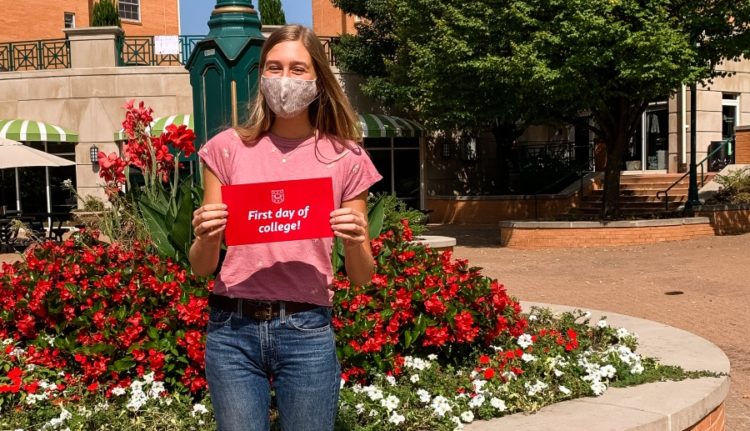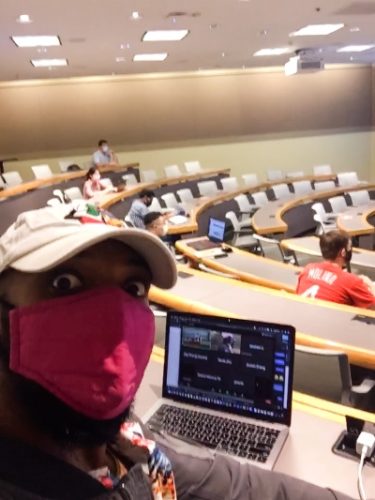With masked faces and generous applications of hand sanitizer, WashU Olin students, staff and faculty members began a fall semester unlike any other on September 14. Students settled into larger-than-usual classrooms (to maintain physical distance) while instructors in face shields stayed within carefully demarcated boundaries at the front of the rooms.
In spite of a world turned topsy-turvy by the coronavirus pandemic, Olin welcomed 121 faculty who started teaching 207 courses over 427 sections. A third of those classes were delivered fully online—because their large enrollment required it—while the rest were either small fully in-person classes or hybrid classes.
Hybrid courses required subsets of the enrolled students to come physically to class some days and participate online other days.
“I was definitely apprehensive about the idea of a hybrid classroom—as well as any type of in-person component, given the circumstances,” said Sydney West, BSBA ’24. “But after my first in-person class, I’m honestly so impressed with how adaptable we are. It’s new to all of us and definitely feels strange, but it seems everyone is generally just grateful to be back in the classroom.”

Quick prep for hybrid classes
For months, instructors prepared to teach online or hybrid classes in collaboration with Olin’s Center for Digital Education while Olin’s staff developed a system to hire, train and schedule “engagement moderators” for each hybrid class, serving as an in-person proxy for students participating through Zoom by monitoring the chatroom and asking questions aloud in the classroom.
In fact, as student hiring ramped up in the first week, dozens of Olin staff members stepped in to serve as engagement moderators. Paulo Natenzon, assistant professor of economics, was thrilled with how his hybrid course went in the first week.
“I’m really happy with how it came out. But I also realize I have many people to thank for that,” he said, crediting Andi McLaughlin, CRM analyst in marketing & communications, for “saving the day at least three times.”
In the first week, 20 students and 42 staff members served as moderators. By the second week, staff had hired enough students to flip the ratio: Of the 76 moderators scheduled, 59 were students and 17 were staff members.
As classes continued, Olin professors adjusted to the reality of teaching courses to students both physically present and “virtually” attending. “Admittedly, I’d love to have more online student interaction. Perhaps the pace of the class makes it challenging to type in a comment before I’ve called on someone,” said Staci Thomas, lecturer in communication and interim director of the management communications center. “I’ve also discovered that breakout rooms need more time to work together than in-person students do.”
Choreographing a new way of learning
Since before the spring semester closed in May, planning had begun for a late start to the fall semester. Those plans included decals and directional signs regulating the flow of people in and out of buildings, a detailed breakdown of available space to maintain physical separation in classrooms and study areas and a comprehensive communication plan to ensure everyone knew what to do, how to do it and when it had to be done.
Olin’s work dovetailed with extensive planning at the university level to align with public health guidelines and provide resources for students when they were on campus.
Jian Cai, lecturer in finance, reflected on how lovely the campus looked in the first week and how welcome the sight of students was.
“The weather was perfect for the first week and the school is in great order,” she said. “Students follow rules very well, from social distancing, cleaning, to entry/exit protocols. They are engaged in the classroom interacting with me. Overall, communication with students flows smoothly.”
And though she was nervous about starting her first classes under the new pandemic-inspired circumstances, she felt well prepared.
Just like it was planned
“Things instructors needed to set up in classrooms worked exactly as I learned in the training sessions,” she said. “I am really touched and thankful to have our staff members facilitate the running of hybrid classes as engagement moderators.”

The first week ended with the first weekend for the next class of Executive MBA students. The 36 students gathered for their classes at the Ritz in Clayton in order to keep the population density as low as possible on the main Olin campus. They are also the first to participate in Olin’s EMBA since a reboot of the program focusing on values-based, data-driven decision-making, digital transformation and leadership development.
Anecdotally, students across the board have offered good feedback about how the semester began. “This first week back was a whirlwind, but of the good sort,” said Tyler Edwards, MBA ’21.
“More than ever,” Cai said, “I feel the close connection within our community, and I am proud to be part of it.”
Pictured above: Professor Andrew Knight teaches a hybrid course in Emerson Auditorium. In front of him, socially distanced students sit in the auditorium, while behind, students participating remotely appear on screen.



